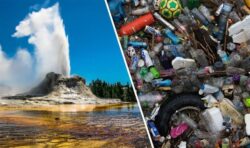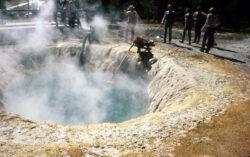Yellowstone Park is the home to many wonderful geothermal features. These include geysers and hot pools, springs, and terraces. Superheated and mineral rich water gushes from the Earth. Tourists often see these beautiful places as the perfect spot to chuck in their trash.
If you have recently visited Yellowstone Park, you may have noticed the hoards of visitors and Park Rangers with large mechanical poles. These expandable tools are required to retrieve tourist trash from the amazing natural features.
Coins, water bottles, facemasks, socks, towels, hats, diapers, handkerchiefs, drones, and anything that could be carried and tossed, are commonly found in the 250-degree pools. The Ranger I talked with complained about retrieving several face masks a day from geysers.
A tourist from the Netherlands was recently fined $3,200 for crashing his drone into the 121-foot-deep Grand Prismatic pool. He lost control of his drone, which are not allowed in the Park. The drone has not been recovered.
Several current geyser eruptions have spewed trash from a century ago. Dated coins, gear, logs, and even a couch are on the list of Geyser Garbage. Apparently, some drunk park staff or guests got carried away.
Morning Glory pool was so full of garbage that it earned the nicknames of “Fading Glory” and the “Garbage Can’. When the National Park Service pumped the pool down, in 1950, and used siphons to remove trash, over 100 vintage objects were retrieved.
Sadly, Yellowstone Geysers have been abused for decades. Early explorers were known to wash their clothes in the geysers. Old Faithful, which erupted regularly, was loaded with dirty laundry. When it erupted, the clothes were blown airborne. They then rinsed them off in the Firehole River and draped them on the trees and shrubs to dry.
Early tourists also bought tons of laundry soap and lye to clean their laundry in the Parks hot water features. Cleaning soaps were a profitable vendor product. Others would load sacks with glass bottles. Metal, cans, and junk that were placed into the limestone geothermal waters. These discolored and mineral covered items were sold as souvenirs.
Trash that is thrown into the pools alters the chemical properties of the pools. Coins are made of copper, silver, nickel, zinc, and other foreign metals. It also clogs the geysers. It can also harm the natural bacteria and unique life that makes these waters their home. “Minute Geyser” once erupted to over 50 feet, every minute. It is now clogged and rarely erupts.
As a kid, I remember seeing old cans, bottles, and even bones from pets or other animals in the clear, deep pools. Organic trash causes other microorganisms to contaminate the pools.
Recent research has discovered many possible uses for the unique life that lives in these pools. Some can dissolve trash and perform other useful environmental tasks.
Geyser basins and waters are highly sensitive areas. Only on trail access is allowed. Sadly, some tourists don’t abide by the park mantra, “leave only a footprint, take only a picture”. They feel a need to leave graffiti, coins, trash, and damage to our natural resources.
We are all Stewards of our wild and beautiful places and parks.
Montana Grant